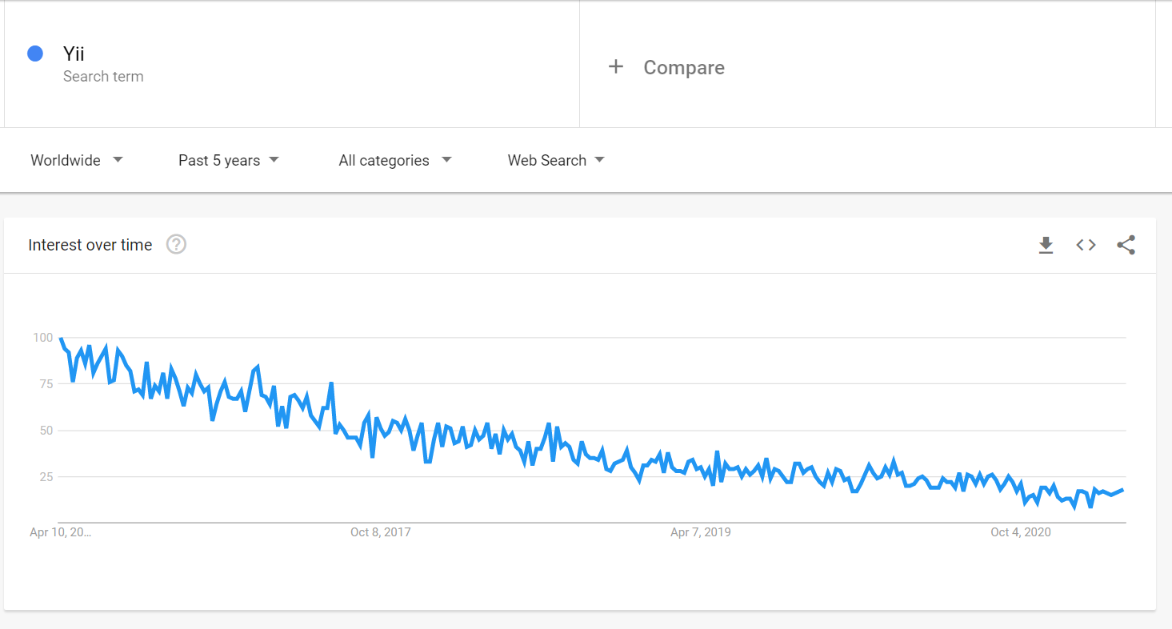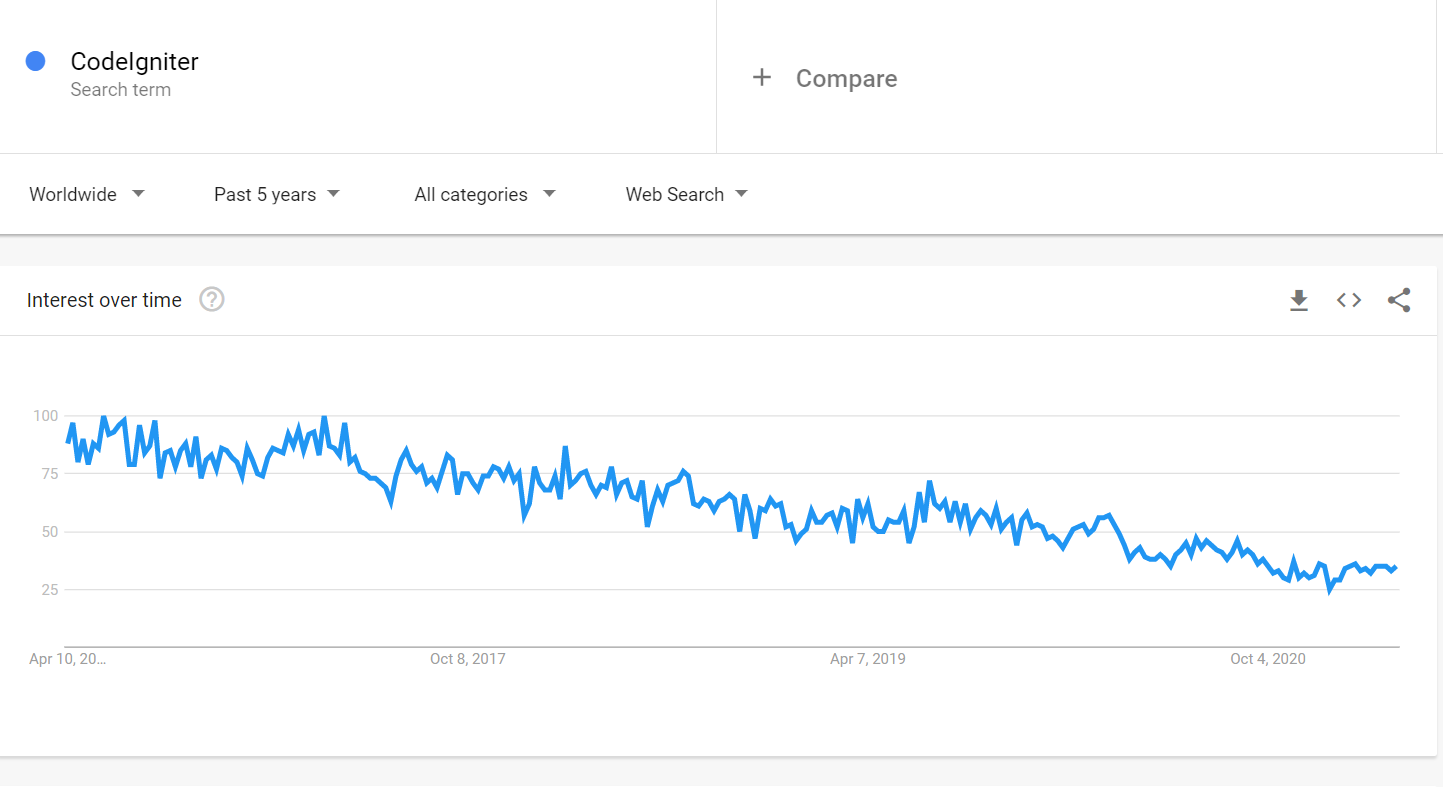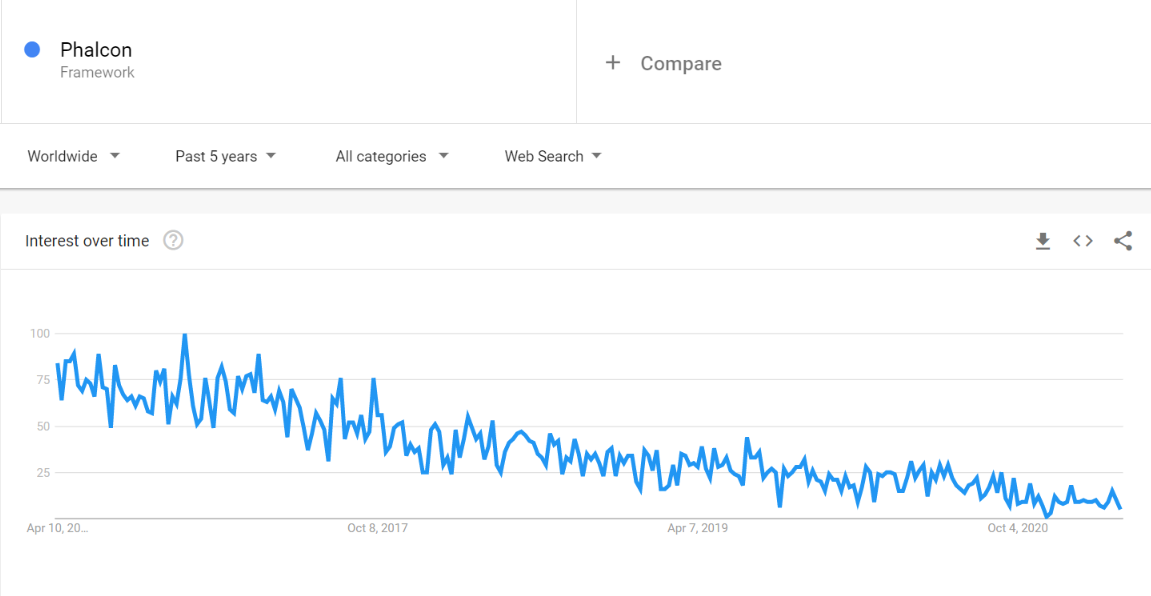PHP is a server-side programming language that works well with both databases and HTML, making it a great choice for digital marketers or developers looking to learn a new language.
But what can you actually do with PHP?
In this article, you’ll find a high-level overview of the most popular PHP frameworks so you can begin imagining what’s possible with this popular language. You’ll learn about Laravel, Symfony, Zend/Laminas, Yii, CakePHP, CodeIgniter, Phalcon, Fat-Free.
See how these frameworks compare according to the following criteria:
- Simplicity and installation of the framework.
- Documentation.
- Flexibility.
- PSR compatibility.
- Project applications.
- Popularity.
You’ll also find a comparison of how many requests each framework could handle per second and learn more about what hosting can be used for each one. Let’s dive in!
Laravel

The Laravel framework allows for beautiful code writing. Laravel will help you facilitate a number of operations such as registration, routing, caching, and working with sessions.
With Laravel, the best features of other PHP frameworks and Ruby on Rails were taken into consideration.
Laravel is a simple yet powerful and flexible tool for creating large projects, even for beginners.
It has:
- Simple and clean routing.
- Easy integration with other PHP libraries.
- A simple and convenient migration system.
- Modular testing.
Installation – In order to install Laravel, your server should have certain modules enabled and you need to follow these requirements of the framework:
- PHP >= 7.2.5
- BCMath PHP Extension.
- Ctype PHP Extension.
- Fileinfo PHP extension.
- JSON PHP Extension.
- Mbstring PHP Extension.
- OpenSSL PHP Extension.
- PDO PHP Extension.
- Tokenizer PHP Extension.
- XML PHP Extension.
The official Laravel team recommends using Laravel Homestead virtual servers where all requirements are already met.
Documentation – This framework has fairly simple and accessible guidelines.
Flexibility – This framework allows extending its functionality. New modules and plug-ins can be installed via composer.
PSR – This framework meets the second version of PSR standards, PSR-2.
Where this framework can be used – This framework is an optimal choice for creating small and medium-sized projects. However, it can also be used to develop large-scale websites.
Popularity of Laravel

Yii 2
 Yii 2 is a high-performance PHP framework that enables you to quickly develop a program.
Yii 2 is a high-performance PHP framework that enables you to quickly develop a program.
This framework can design small, medium, and large projects such as blogs, corporate websites, online shops, portals, CMS systems, RESTful programs, and more. The benefits of this framework include:
- Like most PHP frameworks, Yii uses the MVC (Model-View-Controller) pattern.
- Yii is a full-stack framework that includes a large number of ready-made and tested tools, systems, and codes for ActiveRecord SQL and NoSQL database systems, RESTful API, multi-level caching support, and more.
- Yii is easy to upgrade. You can write your own modules or extensions and extend the framework’s functionality.
- One of the distinguishing features is its high performance, although Yii is quite a massive framework.
- This framework has a code generation module called Gii, which speeds up project development.
Installation – To use Yii2 on your computer, you will need to have PHP 5.4 or higher (ideally the latest, PHP 7) programming language installed. You can install this framework via composer.
The framework enables two types of program frames: basic and advanced. You must choose which version you need upon installation.
Documentation – This framework has a fairly simple instruction manual.
Flexibility – This framework allows extending its functionality. New modules and plug-ins can be installed via composer. You can also create your own extensions.
PSR – This framework meets the second version of PSR standards, PSR-2.
Where this framework can be used – This framework can be used in any project, from simple web programs to RESTful programs, extensive portals, CMS systems, and others.
Popularity of Yii

Symfony

Like Yii, Symfony is a full-stack framework that can be used to create any project. This framework is quite large and rather complicated for beginners.
Symfony is a framework with functionalities according to modern requirements and it is used in particularly expansive projects.
The Drupal CMS is also based on the Symfony framework.
Installation – To use Symfony on your computer, you must have PHP 7.2.5 or higher installed. You can install this framework via composer and Symfony Installer.
The installation of the framework is quite simple. While installing Symfony, you have the chance to choose your future type of program and the corresponding structure will be created based on your choice.
You also have the option to choose one of the following 3 frames:
- Standard Edition is installed by default.
- Hello World Edition is designed for producing benchmarks.
- Symfony CMF Standard Edition is suitable for producing CMSs.
Documentation – The instructions of this framework seemed more complicated to me, compared to those of the Yii 2 and Laravel frameworks.
Flexibility – This framework allows you to extend its functionality. New modules and plug-ins can be installed via composer. You can also create your own extensions.
PSR – This framework meets the second version of PSR standards, PSR-2.
Where this framework can be used – This framework can be used in any project from simple web programs to RESTful programs, extensive portals, CMS systems, and others.
Popularity of Symfony
Zend Framework 3/Laminas

Zend Framework 3 (rebranded as Laminas ) is a free PHP framework created by Zend’s developers. The company is currently engaged in the development of PHP programming language.
This framework has a lot of functionality and can also be used for academic code writing. Zend is an MVC/OOP (Object-oriented Programming) framework, which is used in larger projects.
In order to install Zend, your server must have PHP version 5.6 or higher.
Installation – This framework can be installed via Composer. A ready structure of the program can be taken from Zend skeleton application.
Documentation – This framework has rather simple and comprehensive instructions.
Flexibility – This framework allows extending its functionality. New modules and plug-ins can be installed via composer.
PSR – The second version of this framework complies with PSR-2.
Note: The second version of Zend framework operates quite slowly and requires more effort to complete a project. Since it is an academic framework, all rules to develop a program are maintained. This framework is not for beginners.
Where this framework can be used – This framework can be used mainly for large-scale projects.
Popularity of Zend

CakePHP 4 Strawberry
 CakePHP 4 Strawberry is a free PHP framework that includes codes to develop a program quickly. The MVC template is available in this framework.
CakePHP 4 Strawberry is a free PHP framework that includes codes to develop a program quickly. The MVC template is available in this framework.
CakePHP is an OOP framework, which has quite a lot of functionality, operates fast, and offers great efficiency.
Installation – To use CakePHP, you may need to have PHP 7.2 or higher. You can install this framework via composer. After the installation, you get a ready structure and can build your web app based on it. The installation is usually simple and fast.
Documentation – This framework has a rather simple and comprehensive instruction manual.
Flexibility – This framework allows you to extend its functionality. New modules and plug-ins can be installed via composer.
PSR compatibility – The fourth version of this framework matches PSR-7.
Note: CakePHP 4 had major refactoring and a lot of new improvements introduced in its framework design, speed, and API. The latest version is rather flexible and has greater efficiency than the preceding one. However, its development is very slow.
Where this framework can be used – This framework can be used for almost any project, from simple web programs to REST programs and portals.
Popularity of CakePHP

CodeIgniter
 CodeIgniter is also free of charge and an open-source framework. However, this framework is not designed for large projects.
CodeIgniter is also free of charge and an open-source framework. However, this framework is not designed for large projects.
While one of the fastest frameworks here, it is considered to be dying out since new versions and functionality are rarely released.
The MVC template is also accessible in this framework. CodeIgniter allows you to work with multiple databases such as MySQL, PostgreSQL, Oracle, and more.
It has clear and comprehensive instructions. What’s more, it takes less time to develop a program in this framework.
Installation – To use CodeIgniter you must have PHP 7.3 or higher. Your server must have PHP extensions *intl* extension and *mbstring* extension installed.
You can install this framework via composer.
Documentation – This framework has a rather simple and comprehensive instruction manual.
Flexibility – This framework allows you to extend its functionality.
PSR – The fourth version of this framework matches PSR-2.
Where this framework can be used – I don’t advise using this framework for commercial purposes; only for facilitating studies.
Popularity of CodeIgniter

Phalcon
 Phalcon is also free of charge and an open-source framework. It is one of the fastest frameworks (if not the fastest).
Phalcon is also free of charge and an open-source framework. It is one of the fastest frameworks (if not the fastest).
Its high speed is thanks to the fact that this framework is written in C programing language, though knowledge of C is not required to use it.
Phalcon’s functionality is exposed as PHP classes and interfaces.
Installation – To use Phalcon, you must have PHP 7.2 or higher.
Documentation – The instructions of this framework are not so simple. I found that it took twice as long to get through, compared to all the other frameworks.
Flexibility – This framework allows extending its functionality. New modules and plug-ins can be installed via composer. You can also create your own extensions.
PSR – The fourth version of this framework matches PSR-4.
Where this framework can be used – This framework can be used in any project, from simple web programs to big-scale ones such as online shops, forums, social networks, extensive portals, and others.
Popularity of Phalcon

Fat-Free

Fat-Free is currently the most simple, lightweight, and easy-to-learn framework.
It doesn’t have the extensive capabilities of other frameworks listed here, and when using Fat-Free you will often need to add other third-party libraries as it lacks functionalities.
This framework has:
- Clean Routing Engine.
- Capabilities to create multilingual web apps.
- Cache engine.
- SQL engine support (MySQL, SQLite, PostgreSQL, SQL Server, Sybase, and Oracle).
- Ability to auto-optimize JS/CSS files.
I recommend this framework as a starting PHP framework for beginners.
Installation – To use Phalcon, you must have PHP 5.4 or higher. You can install it either via composer or download a zip archive with complete built.
Documentation – This framework has a fairly simple instruction manual.
Flexibility – This framework allows extending its functionality. New modules and plug-ins can be installed via composer. You can also create your own extensions.
PSR – The fourth version of this framework matches PSR-4.
Where this framework can be used – This framework can be used in any project – from simple web programs to RESTful programs, extensive portals, and others.
Popularity of Fat-Free

Comparing the Speed, Efficiency, & Resource-Saving Features of Frameworks

I tested these frameworks on the same computer and taking the same actions. I used Apache Benchmark as a testing tool.
The computer where the testing was performed has the following specs:
- Linux Mint 17 Cinnamon 64-bit.
- Linux Kernel: 3.13.0-24-generic.
- Processor: Intel Core i3-4160 CPU 3.60Ghz X 2.
- Memory: 8 GB.
- Server version: Apache/2.4.7 (Ubuntu).
- PHP 7.1
What Hosting Can Be Used for PHP Frameworks?
You can install Yii, Laravel, Symfony, Zend, CakePHP, CodeIgniter, and Fat-Free — but not Phalcon — on any popular host including Bluehost, HostGator, A2 Hosting, or SiteGround.
For Phalcon, you need a server where you will need to work with the operating system via SSH as a root user and modify it. Such options may include AWS or DigitalOcean.
Which Framework Is Worth Studying?
CakePHP is slow in developing. Thus, I question whether it is worth learning at this point.
Yii2, Laravel, Zend, and Symfony are currently in compliance with modern standards and requirements. They are in demand and have enormous functionality.
To study these three frameworks, you need to know what MVC means, have a profound knowledge of PHP (including OOP), and be capable of working with databases.
For beginners, it will be easier to start with Laravel and Yii, rather than Symfony or Zend.
More Resources:
- Which Web Design Platform Is Right for You?
- A Beginner’s Guide to ADA Website Accessibility Compliance
- WordPress SEO Guide: Everything You Need to Know
Image Credits
Featured Image: Search Engine Journal
All screenshots taken by author, April 2021


